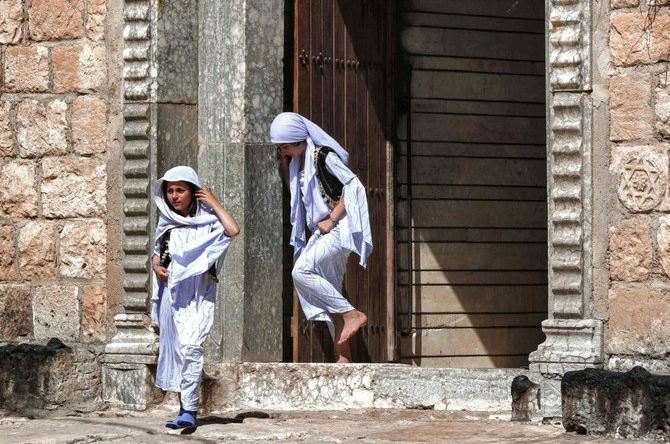The Yazidis of Iraq The atrocities of Daesh shadowed the New Year still
The Yazidis practise an antiquated faith with roots in Zoroastrianism that first appeared in Iran more than 4,000 years ago. It eventually assimilated aspects of both Christianity and Islam.
Lalish – At a revered shrine, members of the Yazidi minority in Iraq light oil lamps one by one to celebrate their New Year. However, for Omar Sinan, the celebration cannot undo the horrors of fundamentalist control.
The Daesh organisation invaded large portions of Iraq in 2014, carrying out horrifying acts of murder against the Kurdish-speaking population, whose non-Muslim faith the fanatics deemed blasphemous.
Daesh kidnapped and sexually trafficked thousands of women and girls while massacring thousands of men.
Tuesday evening, the Yazidis started lighting 365 oil lamps, one for every day of the year, as the sun sank over the Lalish stone sanctuary in northern Iraq.
Hundreds of people attended the Yazidi New Year celebration, which according to the faithful honours nature and fertility as well as the creation of the universe by angels.
The Yazidis arrived in Lalish wearing only white clothes and going barefoot six years after Iraq declared victory over Daesh.
The women wore customary head coverings decorated with gold coins, while the males wore embroidered vests over their shirts.
“In the past, this was a festive time, and we were ecstatic. But today… we can’t let all we’ve been through slip our minds,” said Sinan, who was present for the event with his kids.
The Yazidis practise an antiquated faith with roots in Zoroastrianism that first appeared in Iran more than 4,000 years ago. It eventually assimilated aspects of both Christianity and Islam.
Throughout the years, notably under Saddam Hussein’s rule in Iraq, the community endured persecution.
The historic Yazidi settlement of Sinjar, located in a remote region of northern Iraq on the Nineveh Plain, was one of the targets of Daesh’s August 2014 invasion of the country.
“There has been pain in our hearts ever since the massacre. A 37-year-old maths teacher named Sinan claimed that it would not go.
We shall carry this pain with us forever.
Yazidis pay their respects at the graves of ancestors during the New Year celebration, and those who can afford to sacrifice a sheep and give some of the meat to the less fortunate.
The first Wednesday in April has been designated a holiday for the Yazidi community by the federal government of Iraq in Baghdad.
There were 550,000 Yazidis in the country as of 2014, out of a total of 1.5 million worldwide, including in neighbouring countries and the diaspora.
However, the United Nations reports that almost 100,000 people fled abroad as a result of the killings and kidnappings. Most of them travelled to Europe, Australia, and Canada in an effort to start over.
Faleh Jomaa, a 60-year-old Arabic instructor, made the decision to remain in Iraq with his wife and three children, in contrast to his four siblings and their families, who left for Germany.
“Over time, the Yazidi community has experienced 74 genocides, but it always emerges from the depths of the Earth,” he remarked.
Following similar actions by parliaments in Australia, Belgium, and the Netherlands, Germany’s parliament declared the 2014 Daesh slaughter of Yazidis to be a “genocide” in January.
To enable the displaced Yazidis to return to Sinjar, “political and security measures” have still not been adopted, according to Iraqi Prime Minister Mohamed Shia Al-Sudani on Tuesday.
His government granted $38.5 million in March to reconstruct Sinjar and the Nineveh Plain settlements.
More than 200,000 Yazidis who survived Daesh violence are still displaced, residing in and outside camps throughout Iraq’s autonomous Kurdish area, according to the UN agency for migration, IOM.
The IOM stated in a report from January that “the needs of displaced persons and returnees in Sinjar remain significant,” citing a “lack of appropriate shelter and basic amenities… including…
The IOM stated in a report released in January that “the needs of displaced persons and returnees in Sinjar remain high,” citing a “lack of adequate shelter and basic services… including running water, electricity, health care, and education.”
In Sinjar City and the surrounding districts, Daesh fanatics “destroyed about 80% of public infrastructure and 70% of civilian homes,” the report continued.
Khawla Abdou, who fled to Germany along with her husband and eight daughters, made the decision to spend the New Year in Lalish this time.
The 67-year-old stated, “We came to pray to God on this sacred day so that he may release our daughters who are still being kept by the enemy.
“We pray that God would hear us and deliver our daughters. We will never forget what happened in Sinjar, and we can’t forget them either.
More than 2,700 Yazidis are still missing, some of whom are being held by extremists, according to the IOM.



